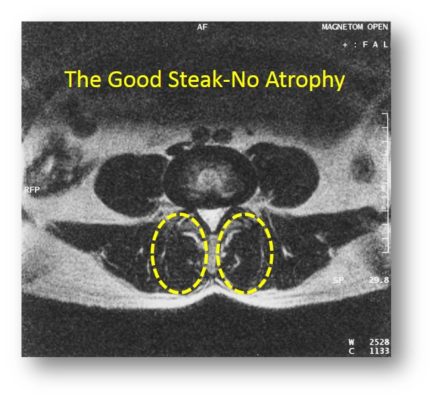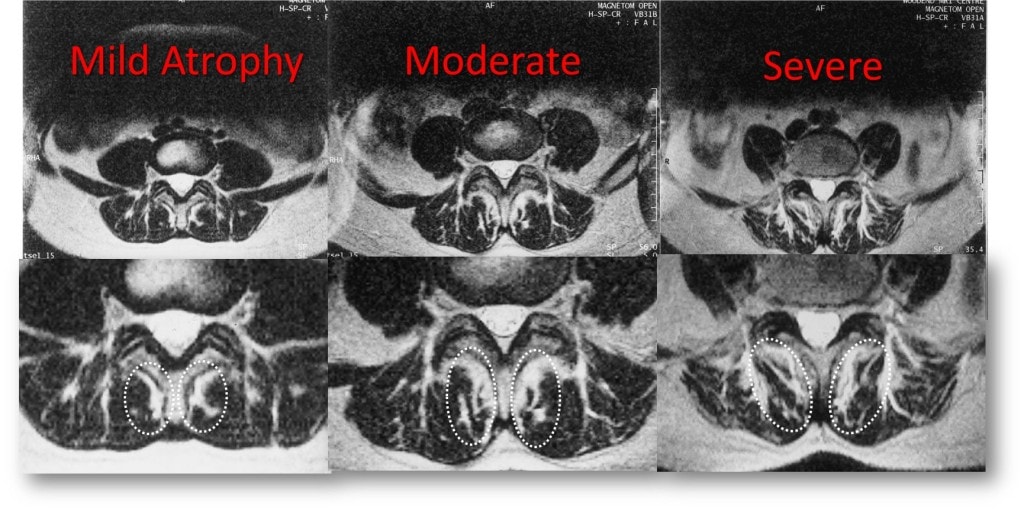Read Your Own Back MRI for Multifidus Atrophy-A Major Cause of Low Back Pain
So now you know what a “multifidus” is and why it’s so critical that you find out if your major low back stabilizing system if off line. However, 99.999% of the time (in my experience), radiologists fail to read whether this muscle is normal or atrophied, despite copious research that a atrophied (read weaker) multifidus is associated with low back and leg symptoms (sciatica).

©Regenexx
So can you read your own MRI? For this easy to see finding, the answer is yes. First, choose the axial T2 sequences (these might be labeled AX T2). If you don’t see “T2”, just pick the axial or ax sequence that looks like the image above, with a whitish circle in the middle (the fluid in the spinal canal) and lots of white to the left and right of the spine (your love handles). These images usually start at the top of the sequence (upper part of your low back) so take a look at the dark areas in the back of the spine (the middle to bottom of the image behind the white circle). This area looks very much like a steak you would buy at the grocery store (see image above). Why does it look that way? Because a steak is a cross section through muscle and so is this picture. Now scroll down through the spine, paying attention to the steak part. Look for what I call “the bad steak” or where the muscles look fatty (see the image above-you want to look in the yellow dashed area for whitish coloring in the otherwise dark muscles). As you start to get to areas where multifidus atrophy shows up, you’ll likely be toward the bottom of the spine (higher image numbers in this sequence).To help guide you, the illustrations below are from one of the original research papers that first described this problem, Kader et al. Note that the area in the white dashed circle has a bit of white (fat atrophy) in the mild picture, more white in the moderate, and is 50% or more white in the severe. We routinely see patients in our office with 80-90% white in this area by the time they see us. Again, look at all levels on the axial images for these white areas.
So what do you do if you have multifidus atrophy? Well it’s usually not as simple as exercises, especially once the muscle gets very atrophied. There is usually low level nerve irritation that’s causing the muscle to shrink, even though you may not think you have a pinched or irritated nerve in the low back. We commonly use the Regenexx-PL-Disc or Regenexx-DDD procedures for these problems, combined with very specific exercises that are designed to get this muscle back on line. We also routinely use ultrasound imaging as part of the exercises as this allows us to know when the patient is contracting this deep muscle. This is because the muscle frequently can’t be felt from the outside.
The upshot? Spend 5 minutes reading your MRI to see if you have this problem, as if you have it, in my experience it’s unlikely that a permanent solution can be found to your pain without addressing the atrophy. This is because every time you move around the muscles that are designed to protect your spine are unable to do so.

NOTE: This blog post provides general information to help the reader better understand regenerative medicine, musculoskeletal health, and related subjects. All content provided in this blog, website, or any linked materials, including text, graphics, images, patient profiles, outcomes, and information, are not intended and should not be considered or used as a substitute for medical advice, diagnosis, or treatment. Please always consult with a professional and certified healthcare provider to discuss if a treatment is right for you.

